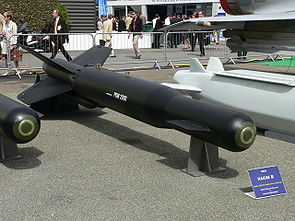PGM (rocket)
| PGM-500/2000 | |
|---|---|
| General Information | |
| Type | Air-to-surface missile |
| Manufacturer | GEC Marconi (now MBDA ) |
| development | 1984 |
| Commissioning | 1994 |
| Unit price | £ 2,000-9,500 |
| Technical specifications | |
| length | PGM-500: 3.384m PGM-1000: 4.623m |
| diameter | PGM-500: 355 mm PGM-1000: 457 mm |
| Combat weight | PGM-500: 404 kg PGM-1000: 1,060 kg |
| span | 1,008 mm |
| drive | Solid rocket motor |
| Range | 50 km |
| Furnishing | |
| Target location | Optionally TV, IIR or laser |
| Warhead | PGM-500: 227 kg PGM-1000: 908 kg |
| Detonator | Impact or proximity fuse |
| Weapon platforms | Dassault Mirage 2000 , Panavia Tornado , SEPECAT Jaguar , Hawker Siddeley Harrier , F-16 Fighting Falcon , F-18 Hornet , F-4 Phantom |
| Lists on the subject | |
The PGM is a British air-to-surface missile that was developed in various versions by the company GEC Marconi (now MBDA ) from 1984 onwards.
During development, there were different project names. Among others, Project Alpha, GMX, Felix, Pegasus, Little Brother or PGM-1 before the decision was finally made for PGM. It was first presented to the public in 1994 and entered service with the British Forces in 1995.
It is available in two different versions, one as the PGM-500 and the PGM-2000. Where the number indicates the weight of the warhead in pounds. In addition to land targets, the PGM (according to the manufacturer) can also be used as an anti-ship missile .
Otherwise the PGM is very modular. Various search heads (TV, IIR, laser) and triggers (impact or proximity detonators) can be mounted.
The PGM is also used by the United Arab Emirates Air Force under the name HAKIM.
Similar models
Web links
- Manufacturer information ( Memento of March 2, 2008 in the Internet Archive )
- www.missilethreat.com ( Memento from October 18, 2012 in the Internet Archive )
